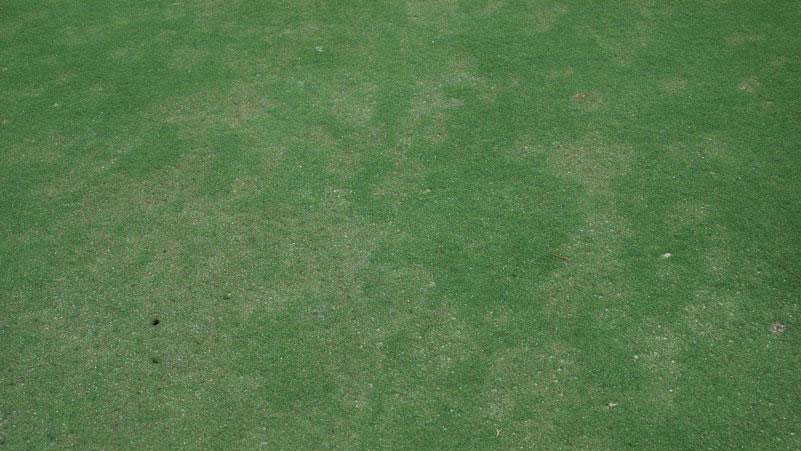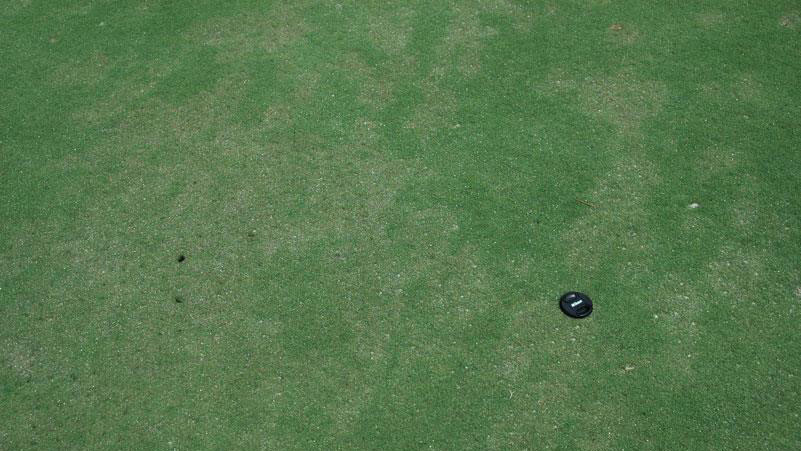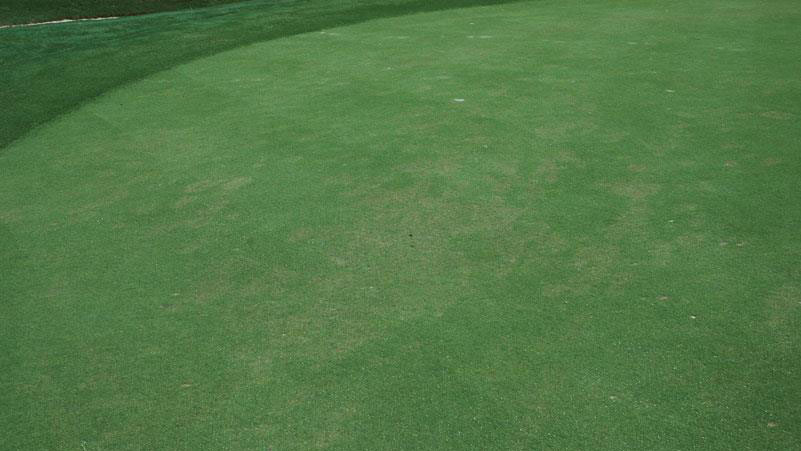Symptoms
Pythium root rot is a persistent problem in areas that are poorly drained or over-irrigated. The disease can also occur in well-drained areas following extended periods of rainfall. Pythium root rot can occur at any time of the year as long as the soil remains saturated for several days or weeks. From a distance, symptoms are orange or yellow and usually appear in irregular patterns, but occasionally develop in spots or distinct patches. Symptoms of Pythium root rot may spread in drainage patterns during periods of heavy rainfall. On individual plants, the crowns, roots, rhizomes, and/or stolons will appear dark and greasy. The depth and density of roots will be drastically reduced in affected areas.
Development Factors
There are many species of Pythium that have the ability to cause root rot of turfgrasses. As a result, Pythium root rot can develop at any time during the growing season if the soil remains saturated for prolonged periods. Poor surface or subsurface drainage, over-irrigation, heavy rainfalls, and excessive thatch and organic matter accumulation are the most common factors that lead to a Pythium root rot outbreak.
Cultural Control
Avoid establishing turfgrasses in poorly drained areas that remain saturated for extended periods. Golf course putting greens must be aerified and topdressed regularly to control thatch and reduce organic matter accumulation. In general, 15% to 20% of the putting green surface area should be impacted by hollow-tine aerification annually, and 5,000 lbs of topdressing should be applied per 1,000 square feet each year. Pruning or removal of trees surrounding putting greens to increase sunlight penetration and air movement will reduce Pythium root rot activity. Installation of high-powered fans will also help to alleviate the problem where air movement is restricted. For golf course putting greens with poor internal drainage, reconstruction is the only practical long-term solution for Pythium root rot.
Chemical Control
Where this disease has been a persistent problem, apply labeled fungicides every 14 to 21 days during the growing season or when rainfall occurs for 2 to 3 consecutive days. For curative applications, first apply ethazole then follow with an application of cyazofamid, picarbutrazox, mefenoxam, or propamocarb 2 to 3 days later. To minimize the potential for foliar burn, ethazole must be watered-in immediately after application with at least 1⁄8 inch of water. Other fungicides should also be watered-in with at least 1⁄8 inch to drive the active ingredient into the root zone where the Pythium root rot pathogens are most active.
* Products marked with an asterisk are not labeled for home lawn use.
| Fungicide and Formulation1 | Amount of Formulation2 | Application Interval (Days)3 | Efficacy Rating | Resistance Risk | FRAC Code4 |
| azoxystrobin (Heritage) WG TL G |
0.2 to 0.4 2 2 to 4 |
10 to 14 10 to 14 10 to 14 |
++ | Medium | 11 |
| azoxystrobin + propiconazole (Headway) ME G |
3 2 to 4 lbs |
14 14 to 28 |
++ | Medium | 11/3 |
| azoxystrobin + propiconazole (Compendium) | 2.6 | 14 | ++ | Medium | 11/3 |
| azoxystrobin + tebuconazole (Strobe T)* | 0.75 to 1.5 | 10 to 21 | ++ | Medium | 11/3 |
| chlorothalonil + fluoxastrobin (Fame C)* | 3 to 5.9 | 7 to 10 | ++ | Medium | M5/11 |
| cyazofamid (Segway) | 0.45 to 0.9 | 14 to 21 | ++++ | Medium | 21 |
|
cyazofamid + azoxystrobin (Union) |
2.9 to 5.75 | 14 to 21 | ++++ | Medium | 21/11 |
| ethazole (Koban)* (Terrazole)* |
4.5 2 to 4 |
10 10 to 14 |
+++ | Low | 14 |
| fluopyram + prothioconazole + propamocarb (Resilia)* | 4 | 14 to 21 | ++ | Medium | 7/3/28 |
| fluoxastrobin (Fame) SC G |
0.18 to 0.36 2.3 to 4.6 lbs |
7 to 10 7 to 10 |
++ | Medium | 11 |
| fluoxastrobin + tebuconazole (Fame T)* | 0.45 to 0.9 | 21 | ++ | Medium | 11/3 |
|
fosetyl Al |
4 to 8 2 to 6 |
14 to 21 7 to 21 |
+++ +++ |
Low Low |
33 |
| mefentrifluconazole + pyraclostrobin (Navicon)* | 0.85 | 14 to 28 | ++ | Medium | 3/11 |
| picarbutrazox (Serata) | 0.6 to 0.8 | 14 | ++++ | Medium | U17 |
| potassium phosphite (Appear II)* | 6 to 8 | 7 to 14 | +++ | Low | 33 |
| propamocarb (Banol)* | 1.3 to 4 | 7 to 21 | + | Medium | 28 |
|
Pseudomonas chlororaphis strain AFS009 (Zio) |
1.8 to 6 | 7 to 21 | + | Not Known | BM02 |
|
pydiflumetofen + azoxystrobin + propiconazole (Posterity XT)* |
3 | 14 | ++ | Medium | 7/11/3 |
| 1 Other trade names with the same active ingredients are labeled for use on turfgrasses and can be used according to label directions. 2 Units are oz, fl oz, or lb depending on formulation. Apply fungicides in 2 to 5 gallons of water per 1,000 square feet according to label directions. Use lower rates for preventive and higher rates for curative applications. 3 Use shorter intervals when conditions are very favorable for disease. 4 Fungicide Resistance Action Committee code. Products with same code have the same mode of action and are in the same chemical class. * Products marked with an asterisk are not labeled for home lawn use. |
|||||
| Efficacy Rating ++++ = excellent control when conditions are highly favorable for disease development +++ = good control when disease pressure is high, excellent control when disease pressure is moderate ++ = good control when disease pressure is moderate, excellent control when disease pressure is low + = good control when disease pressure is low ? = not rated due to insufficient data |
|||||
| Resistance Risk Low = Rotate to different chemical class after 3-4 applications; tank mixing not necessary Medium = Rotate to different chemical class after 1-2 applications; tank-mixing with low or medium risk product recommended High = Rotate to different chemical class after EVERY application; tank-mix with low or medium risk product for EVERY application ? = not rated due to insufficient data |
|||||
Species Data
- HOST SPECIES
- all
- MONTHS WITH SYMPTOMS
- all
- STAND SYMPTOMS
- FOLIAR SYMPTOMS LOCATION / SHAPE
- dieback from leaf tip, blighting of entire leaves
- FOLIAR SYMPTOMS COLOR
- tan, yellow, orange
- ROOT / CROWN SYMPTOMS
- roots, stolons, rhizomes, and/or crowns dark brown or black
- FUNGAL SIGNS
- none
Publication date: Nov. 14, 2017
Reviewed/Revised: Dec. 16, 2019
Recommendations for the use of agricultural chemicals are included in this publication as a convenience to the reader. The use of brand names and any mention or listing of commercial products or services in this publication does not imply endorsement by NC State University or N.C. A&T State University nor discrimination against similar products or services not mentioned. Individuals who use agricultural chemicals are responsible for ensuring that the intended use complies with current regulations and conforms to the product label. Be sure to obtain current information about usage regulations and examine a current product label before applying any chemical. For assistance, contact your local N.C. Cooperative Extension county center.
N.C. Cooperative Extension prohibits discrimination and harassment regardless of age, color, disability, family and marital status, gender identity, national origin, political beliefs, race, religion, sex (including pregnancy), sexual orientation and veteran status.





